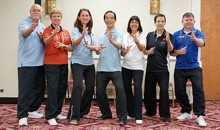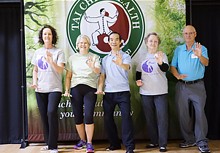Why Tai Chi for Arthritis?
By Dr Paul Lam, with Maureen Miller
Tai Chi for Arthritis is an enjoyable exercise that can relieve your pain, improve your health and your ability to do things. What is more, it is easy to learn — almost anyone can do it. In fact, many people who learn the form, like it so much that they continue to practice and enjoy the benefits of Tai Chi for years. To get started, first, let’s look at a short history of tai chi and its benefits, followed by a brief background as to how Tai Chi for Arthritis came about and some of the medical evidence showing that, practiced regularly, it actually improves health. We’ll conclude with suggestions as to how you can begin to learn Tai Chi for Arthritis.
What is Tai Chi?
Tai Chi originated in ancient China where it is considered a martial art. There is much more to tai chi than one can see, and virtually no one can describe this complex art in a simple sentence. But, basically, tai chi consists of slow continuous whole-body movements, strung together in a form. Like dance, the movements are learned and follow one after the other.
The essential principles of tai chi include mind and body integration, fluid movements, controlled breathing and mental concentration. The central focus is to enable the qi (pronounced chee), or life force, to flow smoothly and powerfully throughout the body. Total harmony of the inner and outer self comes from the integration of the mind and body. This can be achieved through regular practice.
The Benefits of Practicing Tai Chi
Today, tai chi is one of the most effective exercises for the health of mind and body, not only in China, but around the world. Tai chi helps people to relax and feel better. Everything improves when you are more relaxed and feeling good about yourself.
The National Institute of Health’s National Centre of Complementary and Alternative Medicine found, in a 2007 survey, that more than 2.3 million Americans practice tai chi for various health-related purposes, including:
• to obtain benefits associated with low-impact, weight-bearing, aerobic exercise;
• to improve physical condition, muscle strength, coordination, and flexibility;
• to improve balance and decrease the risk of falls;
• to ease pain and stiffness;
• to improve sleep; and
• for overall wellness.
Harvard Medical School, in their May 2009 Health Publications, suggests that tai chi, which is often called meditation in motion, might well be referred to as “medication in motion”. For, in addition to preventing falls and reducing the effects of arthritis, the practice of tai chi has been shown to be helpful for a number of medical conditions including; low bone density, breast cancer and it’s side effects, heart disease and failure, hypertension, Parkinson’s disease, sleep problems, and stroke.
Tai chi is especially suitable for older adults because its level of exertion can be adjusted for each individual. From my own experience in many years of teaching, I have found that people adhere to their tai chi practice because they enjoy it, it is easily accessible, and there is no need for special clothing or equipment. For many, like myself, practicing tai chi continues as a lifetime journey, as it is an art with great depth.
The Tai Chi for Arthritis Program
There are many styles and forms of tai chi; the major ones being Chen, Yang, Wu, another Wu (actually two different words in Chinese) and Sun. Each style has its own unique features, although they share the same essential principles. Traditional tai chi forms are complex, as they were mainly used for martial arts. Unfortunately, many of these also contain movements with a high risk of injury. As the purpose of learning tai chi changed from martial arts for the elite to improving health, I had the idea of partnering with a teams of tai chi experts, medical specialists and education experts to create easy to learn, safer and more effective tai chi forms. Thus was born the Tai Chi for Arthritis program, which was soon followed by several other Tai Chi for Health programs.
According to traditional Chinese medicine, qi is essential for health and vitality. Tai Chi for Health programs are designed to enhance qi. Thus, practice of the forms not only improve the specific condition each program addresses, but also benefits almost all aspects of health. Tai Chi for Arthritis is easy to learn — most people can learn it in days, weeks and, at most, several months. It is also safe. All high risk movements have been removed and replace with ones that are more effective for health. In addition certified Tai Chi for Arthritis instructors are trained to teach safely.
The Tai Chi for Arthritis program is effective. Over ten scientific studies have shown it relieves pain, maintains and improves health and the quality of life. Because of this arthritis organizations, including the Arthritis Foundations in USA and Australia, Arthritis Care of UK, and Osteoporosis Australia, are supporting it.
As Tai Chi for Arthritis can be practised sitting as well as standing, almost anyone, of any physical condition, can begin and continue to progress regardless of age.
How Tai Chi for Arthritis Benefit Your Health?
As an effective program for people with arthritis, Tai Chi for Arthritis incorporates exercises that improve muscular strength, flexibility and fitness.
- Muscle strength is important for supporting and protecting joints. It is essential for normal physical function.
- Flexibility exercises enable people to move more easily. Flexibility also facilitates the circulation of body fluid and blood, which enhances healing. Many arthritic conditions such as fibromyalgia, scleroderma and spondylitis are characterized by joint stiffness and impaired physical function. Tai chi gently frees up stiff joints and muscles.
- Fitness is important for overall health and proper functioning of the heart, lungs and muscles. Tai Chi for Arthritis can improve all of these components.
The Tai Chi for Arthritis program also focuses on weight transference, which improves balance and prevents falls.
Additionally, tai chi practice helps to relieve pain and reduce stress This is accomplished in various ways. First, Increasing muscular strength helps to protect the joints, thereby reducing pain. Second, improved flexibility allows for better blood and joint fluid circulation, which also leads to less pain. Third, tai chi is a mind body exercise, which improves the serenity and relaxation of the mind and thus reduces pain and stress. As a result, those who practice tai chi often experience less depression and enhanced immunity.
The Scientific Evidence
Several representative studies follow. More information is available on request.
The largest study of Tai Chi for Arthritis, by Professor Leigh Callahan from the University of North Carolina, shows significant health benefits for people with all types of arthritis. This landmark study was presented at the annual Scientific Meeting of the American College of Rheumatology on 8th November 2010.
In the study, 354 participants were randomly assigned to two groups. The Tai Chi group received 8 weeks of lessons, while the other group was a control group waiting for Tai Chi classes. It was found that there was significant pain relief, less stiffness and better ability to manage daily living. The participants felt better about their overall wellness, as well as experiencing improved balance.
In September 2003, the Journal of Rheumatology published a study that compared older adults with arthritis. After 12 weeks, those that practised the Tai Chi for Arthritis form had 35% less pain, 29% less stiffness, 29% more ability to perform daily tasks (like climbing stairs), as well as improved balance, compared to the control group.
The Journal of Advanced Nursing reports the results of a 2005 study on “The Effects of Sun-Style Tai Chi Exercise on Physical Fitness and Fall Prevention in Fall-Prone Adults”. Subjects were tested, before and after, practicing Tai Chi for Arthritis three times a week for 12 weeks for strength of the knee and ankle, flexibility and mobility, and the risk ratio of falls. It concluded that this tai chi program can safely improve physical strength and reduce fall risk in fall-prone older adults in residential care facilities.
Arthritis Care and Research published a study in April, 2007, which observed that older, sedentary people with chronic osteoarthritis (OA) of the knee or hip, gained significant and sustained improvement in physical function as well pain relief with Tai Chi for Arthritis classes.
The largest tai chi for fall prevention study in a community setting was published by the American Journal of American Geriatric Society in August 2007. Subjects practised a modified tai chi program, which incorporated 80% of the Tai Chi for Arthritis program. The results indicate that recurring falls were reduced by nearly 70%.
A two year tai chi study, published by Asian Nursing Research in December, 2008, discovered that practicing Tai Chi for Arthritis led to improving six out of eight quality of life measurements for older adults. And, after a half year, there were practically no drop outs. 
Learning the Tai Chi for Arthritis Program
Learning the Tai Chi for Arthritis program can be an engaging and rewarding experience. Today, over a million people around the world have enjoyed learning and gaining benefits from the program. Below are three steps you can take to join them:
• Enroll in a class conducted by one of my certified instructors, or use my step-by-step instructional DVD.
• Follow the instructions, learn and practice regularly. Give yourself time to absorb and understand the essential principles of tai chi – this will enable you to enjoy your practice, gain health benefits and progress steadily.
• Keep an open mind to different aspects of tai chi, continue to learn from your instructor, friends and other teachers or resources. You can use my tai chi books and articles to learn more about tai chi and join in our discussion forum with other students and instructors.
Whether you have arthritis or not, practicing Tai Chi for Arthritis will improve your balance, reduce falls, reduce stress and improve serenity. In fact, it will improve practically all aspects of your health.
Summary:
Dr. Paul Lam, a family physician and tai chi expert, worked with a team of tai chi and medical specialists to create the Tai Chi for Arthritis program. The special features of this unique program are that it is easy to learn, enjoyable, and provides many health benefits in a relatively short period of time.
Medical studies have shown that practicing this program reduces pain significantly, prevents falls for the elderly, and improves many aspects of health. For these reasons, Arthritis Foundations around the world have supported the program; in particular the Arthritis Foundation of America who, after collaborating with Dr. Lam to produce a 12 lesson Tai Chi for Arthritis instructional DVD, promotes the program throughout USA.
Tai Chi for Arthritis is based on Sun style tai chi. Most people can learn the basic Tai Chi for Arthritis movements in 8 to 12 one hour lessons, with regular practice in between the lessons. The entire program has much depth, allowing one to continue to improve, reach a higher level of tai chi, and enjoy greater health benefits for many years.
National Institute of Health: National Centre of Complementary and Alternative Medicinehttp://nccam.nih.gov/health/taichi/
Rhayun Song, Eun-Ok Lee, Paul Lam, Sang-Cheol Ba; “Effects of tai chi exercise on pain, balance, muscle strength, and physical functioning in older women with osteoarthritis: A randomized clinical trial”, The Journal of Rheumatology, September, 2003.
Dr Choi J.H., Moon J.S. and Song R. (2005) "The Effects of Sun-Style Tai Chi Exercise on Physical Fitness and Fall Prevention in Fall-Prone Adults", Journal of Advanced Nursing, 51(2), 150-157
Fransen M, Nairn L, Winstanley J, Lam P, Edmonds J. A; “Randomized Control Trial Of 200 Subjects Comparing Tai Chi, Hydrotherapy And Control, To Measure Improvement In Pain, Physical Function, Muscular Strength And Walking Capacity”. Arthritis Care and Research.. Vol.57, No.3, April 15, 2007, pp407-414.
Alexander Voukelatos, MA (Psychol),_ Robert G. Cumming, PhD,wz Stephen R. Lord, DSc, and Chris Rissel, PhD; “A Randomized, Controlled Trial of tai chi for the Prevention of Falls: The Central Sydney tai chi Trial”. Journal of American Geriatrics Society, AUGUST 2007–VOL. 55, NO. 8.
Ching-Huey Chen, Miaofen Yen, Susan Fetzer, Li-Hua Lo, Paul Lam; “The Effects of Tai Chi Exercise on Elders with Osteoarthritis: A Longitudinal Study”, Asian Nursing Research December 2008 Vol 2 No 4.
Harvard Medical Newsletter:https://www.health.harvard.edu/newsletters/Harvard_Womens_Health_Watch/2009/May/The-health-benefits-of-tai-chi
New Zealand, Accident Compensation Corporation: http://www.acc.co.nz/preventing-injuries/at-home/older-people/information-for-older-people/modified-tai-chi-classes/PI00015
Dr. Paul Lam, a family physician and lecturer of the University of New South Wales in Sydney, Australia since 1976, is a world leader in the field of tai chi for health improvement. Dr. Lam has composed several Tai Chi for Health programs that are supported by organisations including the Arthritis Foundations of America and Australia, Osteoporosis Australia, Arthritis Care, UK and Diabetes Australia. There are over twenty published studies on the health benefits of the Tai Chi for Health programs.
Dr Lam has written four books: Overcoming Arthritis, Tai Chi for Diabetes; Tai Chi for Beginners and the 24 Forms and Teaching Tai Chi Effectively.

